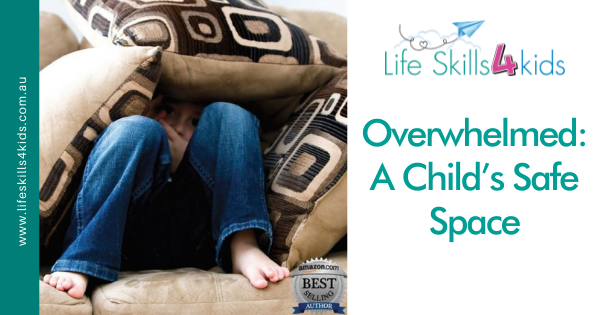Overwhelmed: A Child’s Safe Space
Written by Deb Hopper
Published in
Navigating through the day as a child can be an exhilarating, yet daunting process. There is the fun and joy of play, friends and family. There is also the challenge of meeting new people, the social challenges of interaction with play, the environmental challenge of coping with noise, lights and movement at preschool or school or at the supermarkets. Just as adults, if the challenges outweigh our capacity, children can experience stress and overwhelm.
The signs of overwhelm are exhibited differently between different children but may include:
- needing to take control of situations that may be seen as being bossy or dominant in play
- meltdowns and crying
- ‘behavioural’ issues, whining, clinginess or oppositional behaviour.
These signs or clues that your child may be overwhelmed may be shown more at home, at school or both. Many children can ‘hold it together’ at preschool or school, but once safe at home, they feel safe and their emotions overflow.
Other children find the preschool/school environment overwhelming and their stress cues/signs are more pronounced at school. Either way, it’s important to be a detective and notice the signs of overwhelm and once identified, put a plan of reducing this stress before it escalates.
It is also important to be aware that overwhelm may come from a combination of at least 2 sources. Mental or emotional overwhelm – feeling that the demands of a task are way too difficult, or sensory overwhelm – with factors of the environment being too much to handle. Examples of sensory overwhelm might include too much noise, glare or too much light, not liking the feeling of touch of some objects such as tags in shirts, seams in socks or messy glue.
How to create a safe space when your child is overwhelmed.
When a child shows signs of overwhelm, it’s important to provide a safe place. This might be a physically safe space, or it may be simply verbal acknowledgement that it looks as if things are difficult.
Five top ways to reduce overwhelm for a child may include:
1. Create a physical space in a corner of a room at home or in the classroom such as a small tent. A safe space could include cushions, fidget toys, favourite books, a bean bag half-filled so they can nestle in and feel safe, a heavy blanket, calm music and fairy lights or oil timers or oil toys. This can be called the safe space, or create a fun name for it that your child owns.
2. Have a conversation about the reason why they may feel overwhelmed. Tell them you want to help them, but that you need some clues as to why they feel this way and then tell them you can help think of some ways to make things easier.
3. Use a visual chart such as the Just Right Kids Technique Model (see link below) to help kids map and point out how they are feeling. A visual map helps them to identify how they feel and having them being able to communicate about this, can relieve some stress and worry.
4. Give them verbal permission that if they are feeling sad, overwhelmed, angry or mad that they can come and tell you, or that they can take themselves straight to the safe place.
5. Empower your child or the children you work with to know that having feelings and emotion, including being overwhelmed is normal, but that there are ways that we can help change how we feel, including using a safe space as in point 1 above.
As parents, carers and teachers, we tune in to the needs of the children in our life. However, sometimes we can become a little disconnected or busy and not notice the cues of overwhelm. Creating a sensory safe space is one strategy that can be used to help children cope with overwhelm. Teaching a child to have more independence in knowing their emotions and experimenting with strategies to reduce stress, is a great life skill that will be well used through to adult hood.
_____________________________________________________________
Download this article to print easily here:Deb Hopper Overwhelmed-A-Childs-Safe-Space
Deb Hopper… Occupational Therapist, author, workshop presenter. Deb is passionate about empowering parents and educators to understand the underlying reasons of why children struggle with behaviour, self-esteem and sensory processing difficulties. A practicing Occupational Therapist, she understands the daily struggles that children, parents and teachers face.
Deb is the co-author of the CD Sensory Songs for Tots, and author of Reducing Meltdowns and Improving Concentration: The Just Right Kids Technique. The Just Right Kids Technique Model can be downloaded at: http://www.lifeskills4kids.com.au/just-right-kids-model/
You can contact Deb on 02 6555 9877. She is available for clinic and phone/ Skype consultations.


